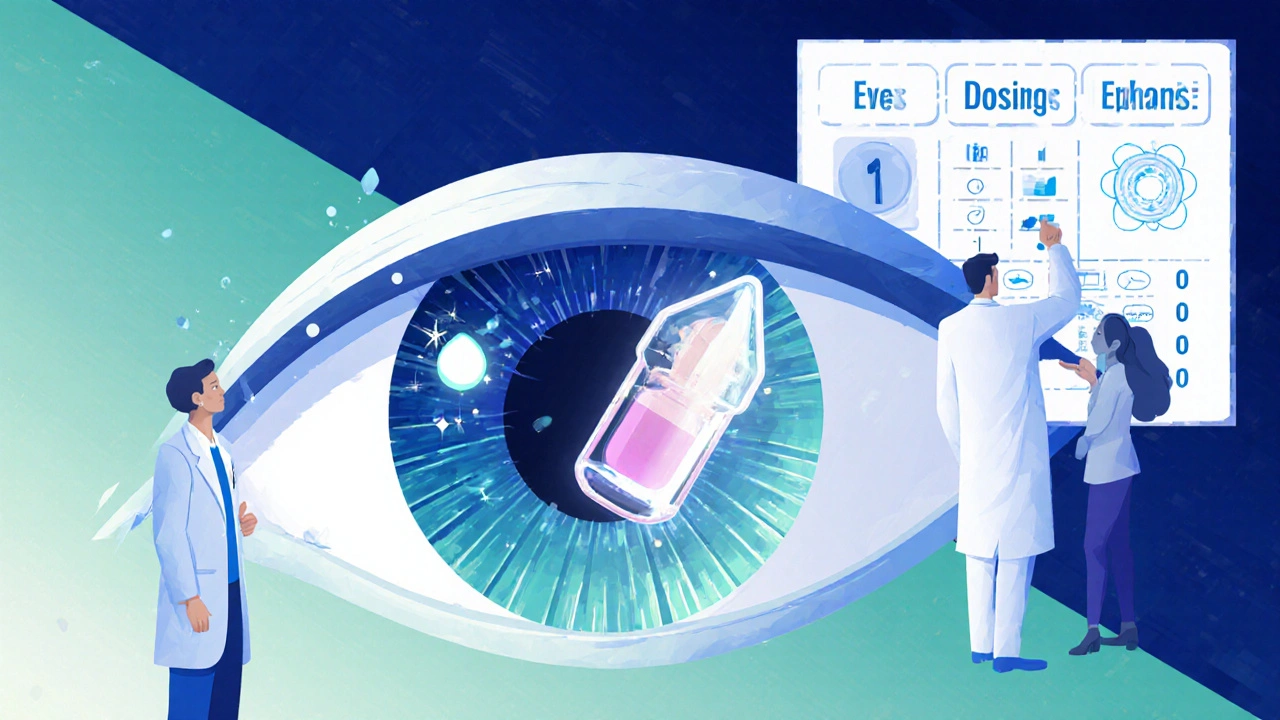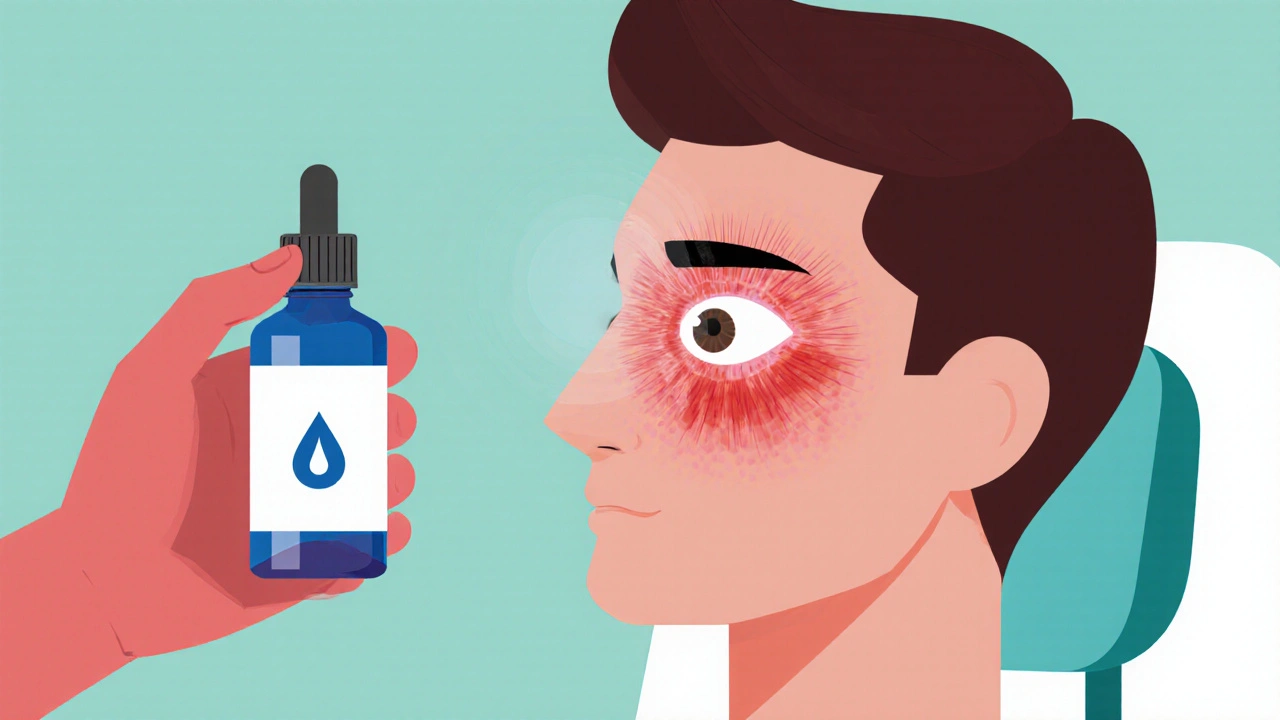Steroid Eye Drop Dosing Calculator
Calculate Your Dosing Schedule
Results
Recommended Schedule
Calculate your schedule to see personalized dosing recommendations
Risk Assessment
No risk assessment available until calculation is complete
Practical Tips
No practical tips available until calculation is complete
After eye surgery, most patients notice redness, swelling, and light sensitivity. Those symptoms are signs of postoperative ocular inflammation, and if left unchecked they can slow healing or even damage vision. One of the most effective ways to tame that inflammation is with corticosteroid eye drops. Below we break down why steroids are the go‑to choice, how they compare to other options, and what you need to watch out for.
What Triggers Inflammation After Eye Surgery?
Any intra‑ocular procedure-whether cataract extraction, retinal repair, or laser capsulotomy-disrupts delicate eye tissues. The trauma releases inflammatory mediators such as prostaglandins, cytokines, and leukotrienes. Common manifestations include:
- Anterior chamber cells and flare (visible as haze in the front part of the eye)
- Conjunctival hyperemia (redness)
- Corneal edema (swelling)
- Pain or pressure sensation
While the body’s response is natural, excessive inflammation can lead to complications like posterior capsular opacification or secondary glaucoma.
How Corticosteroid eye drops are anti‑inflammatory agents that mimic the body’s natural hormone cortisol, suppressing the immune cascade that causes swelling and pain in the eye Work
Corticosteroids bind to glucocorticoid receptors in ocular tissues. This binding shuts down the production of prostaglandins and reduces the migration of inflammatory cells. The result is faster resolution of cells and flare in the anterior chamber, less pain, and clearer vision sooner.
Common Steroid Formulations Used After Surgery
Not all steroid eye drops are created equal. Here are the most frequently prescribed types:
- Prednisolone acetate a potent, oil‑in‑water emulsion that provides sustained drug contact with the cornea - often dosed every 1-2hours initially.
- Dexamethasone phosphate a water‑soluble steroid that works quickly but may require more frequent dosing - popular after retinal procedures.
- Loteprednol etabonate - a “soft” steroid designed to minimize intraocular pressure spikes.
- Fluorometholone - less potent, used when the surgeon wants a gentler anti‑inflammatory effect.
Typical Dosing Schedule and Tapering Strategy
Most surgeons start with an intensive regimen-one drop every hour while the patient is awake-for the first 24‑48hours. After that, the frequency is gradually reduced:
- Day 3‑5: every 2hours while awake.
- Week 1: every 4hours.
- Weeks 2‑3: 1‑2 drops per day.
- Week 4 onward: stop or switch to a milder agent if inflammation has resolved.
The taper is key. Stopping steroids abruptly can cause a rebound flare, especially in eyes that were highly inflamed.
Steroids vs. NSAIDs: Which Is Better?
Nonsteroidal anti‑inflammatory drugs (NSAIDs) also target prostaglandins, but they do so by inhibiting the COX enzymes rather than suppressing the whole immune cascade. Below is a quick side‑by‑side look.
| Feature | Steroid Eye Drops | NSAID Eye Drops |
|---|---|---|
| Mechanism | Blocks multiple inflammatory pathways via glucocorticoid receptors | Inhibits COX‑1/COX‑2, reduces prostaglandin synthesis |
| Onset of action | 1-2hours | 4-6hours |
| Peak efficacy | Strong - resolves cells/flare quickly | Moderate - good for mild to moderate cases |
| Risk of increased intraocular pressure | Intraocular pressure can rise in steroid‑responsive patients, sometimes leading to glaucoma | Rare |
| Cataract formation | Possible with long‑term use | Not applicable |
| Typical duration of therapy | 2‑4weeks with taper | 2‑3weeks, often without taper |
| Common brand examples | Pred Forte®, Durezol® | Ketorolac (Acular®), Nepafenac (Nevanac®) |
In practice, many surgeons combine a short‑course steroid with an NSAID to get the rapid anti‑inflammatory punch of steroids while protecting the cornea from NSAID‑related epithelial toxicity.
Managing Steroid‑Related Side Effects
The two biggest concerns are intraocular pressure elevations that can precipitate secondary glaucoma if not caught early and steroid‑induced cataract formation, especially in patients with already compromised lenses.
Steps to mitigate risk:
- Measure baseline intraocular pressure (IOP) before starting steroids.
- Re‑check IOP at 1‑week and 4‑week visits.
- Switch to a “soft” steroid like loteprednol if the patient shows a pressure rise of >4mmHg.
- Consider adding a topical beta‑blocker (timolol) temporarily if pressure spikes.
For cataract risk, keep steroid courses under 4weeks whenever possible and taper slowly. Most post‑cataract surgery patients already receive an intra‑ocular lens, so the visual impact of a steroid‑induced posterior subcapsular cataract is usually minimal, but it’s still worth monitoring.

Practical Tips for Surgeons and Patients
Even the best drug won’t work if the patient can’t use it correctly. Here are some real‑world pointers:
- Educate on proper drop technique: Pull the lower eyelid down, squeeze one drop, close the eye gently for 2minutes, and avoid blinking immediately.
- Use a dosing chart that the patient can stick on the bathroom mirror. Visual cues reduce missed doses.
- Coordinate with pharmacy to ensure the prescription includes a “taper” instruction; many pharmacies will default to a flat 30‑day supply otherwise.
- Schedule follow‑up visits at day 1, week 1, and week 4 to assess inflammation, IOP, and visual acuity.
- Combine with topical antibiotics (e.g., moxifloxacin) for the first 24‑48hours to prevent infection while the steroid suppresses the immune response.
Patients who report persistent redness, pain, or decreased vision after the first week should be examined promptly; these could signal infection, an inadequate steroid response, or a pressure rise.
Future Directions: New Steroid Delivery Systems
Research is exploring sustained‑release steroid implants placed in the anterior chamber (e.g., Ozurdex® for posterior segment, but newer anterior versions are in trials). These devices could eliminate the need for frequent drops, especially in patients who struggle with compliance.
Another promising avenue is nano‑emulsion formulations that increase corneal penetration while reducing systemic absorption.
Frequently Asked Questions
Can I use steroid eye drops if I have glaucoma?
Only under close supervision. Patients with known steroid‑responsive IOP spikes should start with a low‑potency “soft” steroid and have pressure checked within 48hours.
Do NSAID eye drops replace steroids completely?
Rarely. NSAIDs are excellent for mild inflammation and for protecting the corneal epithelium, but they don’t quell the cellular immune response as powerfully as steroids.
How long does it take for inflammation to subside with steroids?
Most patients see a noticeable reduction in redness and cells within 24-48hours, with near‑complete resolution by the end of the first week.
What signs indicate a dangerous rise in intraocular pressure?
Sharp eye pain, halos around lights, headache, or a sudden drop in visual acuity. An IOP reading above 25mmHg also warrants immediate action.
Is it safe to combine steroids with antibiotics?
Yes, and it’s common practice. The antibiotic prevents infection while the steroid controls inflammation; just avoid topical antibiotics that contain preservatives known to irritate the cornea.


Winston Bar
Another marketing gimmick, same old steroids.